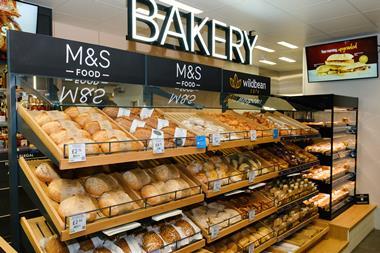Attracting higher spending top-up shoppers should be a key aim for forecourt retailers, according to the Institute of Grocery Distribution (IGD), and chilled and fresh is the category that’s most likely to draw them to your store. Indeed, 37% of consumers have said that stocking up on fresh foods was the main reason they shopped in between their main grocery shopping trips - second only to replacing things they’d run out of.
M&S Simply Food entering the forecourt fray - bringing with it a high-quality range that is 60% chilled - really raises the bar for other retailers. And with health issues at the top of everyone’s agenda, the chilled and fresh category has huge potential all round. The main challenge for independent retailers is to make sure they have a serious offer - and that customers know about it.
Showing that you’re really in the food business is the key to enticing those top-up shoppers. According to the IGD’s ’Opportunities for Growth in Forecourt Retailing’ report, retailers still have some work to do when it comes to changing public perception of what a modern forecourt really offers. The problem is that the activities of food and fuel retailing have not always been synonymous and, as a result, forecourt stores aren’t always seen as automatic top-up shopping destinations.
While the majority of sites do very well on food-to-go and distress purchases, some need to educate consumers or risk losing valuable top-up shoppers to more traditional convenience stores. Customer awareness of the ranges stocked can be low - 23% of customers still believe that forecourts do not sell chilled dairy products, according to research from HIM’s Convenience Tracking Programme, although those aligned with a symbol fascia did score better.
Kenton Burchell, category manager for chilled at Musgrave Budgens Londis (MBL), says that retailers who want to maximise the chilled opportunity need to offer a combination that focuses on convenience but without neglecting those all-important top-up products, such as fresh meat and meal solutions. "Obviously, in forecourt outlets, customers expect to be able to buy items such as sandwiches, pastries, one-shot juices, smoothies and flavoured milk, he says. "But, as forecourt stores’ fresh and chilled ranges have improved beyond recognition over the past few years, so consumers’ expectations have risen. If you can provide them with the range, quality and availability that they’re looking for, they will use you as a destination shop and not just for impulse purchases."
Scott Annan, director at convenience retail consultancy SRCG, believes that stores need to build consumer trust by conveying an overall ’foodie’ feel rather than an ’oily’ one. "The key thing is to make sure it looks like you’re serious about food," he says. "Your staff should look like they’re in the food business rather than the petrol business and get them to talk about it and highlight the offer to customers."
Fresh fruit and vegetables are particularly useful when it comes to creating a positive perception and retailers are switching on to this, with participation in the category gaining another 7% last year, according to the IGD. Stuart Cordner, regional fresh foods manager for Hendersons, says: "We put fruit and veg near the front door or in the first aisle as it acts as a barometer of freshness for the rest of the store. It creates impact and colour. If it’s near the front, staff will also pay more attention to it, turnover of stock will be quicker and the quality will be higher than if it’s tucked away."
Fresh bagged salads can also work well as part of both the lunchtime and evening meal opportunities. Spar launched an own-label range last summer, while Vitacress also has a range of branded washed and ready-to-eat salads, including organic variants.
According to Tom Fender at HIM, the single biggest thing holding retailers back in chilled and fresh is concerns over wastage. "The problem is that to build credibility and awareness retailers need to have full stocks at all times," he says. "This inevitably leads to wastage. Reducing wastage means reducing availability, meaning no sales." Fender says that wastage is a necessary evil to begin with and retailers must look at the bigger picture and see it as an investment. "Fresh is usually high-margin, so throwing some away still makes the category overall one of the most profitable. Some companies set minimum wastage targets to show commitment to the category, and M&S has said recently that the more they throw away the more they sell."
Fender firmly believes that independents can compete with the likes of Tesco Express and the other major multiples, particularly when it comes to locally-sourced foods. "Some independents go out of their way to get great produce by being the first to local markets," he says. "Indies can exploit the desire for locally-sourced products much more easily than managed chains. They need to commit to it, make it first in flow in their stores and have great availability. They could tie up with local specialist suppliers such as a butcher or baker to sell their products in store."
One retailer who is using the category to compete with the supermarkets in a different way is Mike Dearing, of Chatham Road Services in Maidstone, Kent. An aggressive pricing campaign on milk at Mike’s Mace-branded store has seen sales increase by 70%. His store is currently cheaper than Sainsburys, Tesco, and the three Shell company-owned sites nearby - a fact that is well advertised on his shelves.
"We’ve taken a slight drop in profit, but we’re still making money on it and we’re selling more, so it’s worth it," he says. "We’ve probably been guilty of over-pricing in the past - after all, we’re trying to run a tight business like everyone else.
"Now we’re trying to give the customer more of an offer to encourage them to shop here and to keep coming back."
Chilled snack foods for customers to eat on the move continue to be a growth area for the forecourt sector, with Ginsters now the leading brand in both savoury pastries and pre-packed sandwiches - one of the most profitable lines in the chiller.
During 2005 Ginsters sandwich sales were up 9% and one of the fastest growing parts of its range was the fresh tortilla wraps, launched in 2004. Last month also saw the addition of ’Less than 350 calories’ chicken tikka flavour to its healthier eating range, the first new product in a range of planned extensions for 2006.
Country Choice has also been adding new varieties to its fresh sandwich fillings range, which are supplied in 1kg units for on-site sandwich or filled baguette operations. These include a luxurious crayfish filling in a delicate lemon and dill mayonnaise and pesto chicken.
Pork Farms is another leading brand in the chilled savoury pastry sector. It is currently offering a promotional pack of three snack-size pork pies for the price of two. These are available until March 31 through Kerry Foods Direct to Store.
Geo Adams also supplies a diverse range of chilled food-to-go, including pies and pastries, such as the best-selling Jumbo Lincolnshire Pork Roll, and pasta salads with an attached ’spork’. The brand has recently been relaunched, with new bright red packaging for more on-shelf presence.
Also jostling for space in the chiller are fresh microwaveable sandwiches and burgers. Eatwell UK’s Feasters range now includes a microwaveable baguette, which is bought chilled but served hot. It is ready to eat after two minutes in the microwave.
Rustlers also offers a range of burgers, hot dogs and filled baps and has created a ’Grab and Go’ concept, which gives consumers the option of heating products themselves on-site, through the provision of a branded, in-store microwave.
RETAILER VIEW
Sarah Rashid manages a Budgens independent forecourt store owned by her parents, Maggie and Karim, in Frilford near Abingdon, Oxfordshire.
"There are limited profits from fuel and I really believe that to thrive we forecourt retailers have to focus on our food offer and in particular on our fresh and chilled ranges. When we first opened we had to get to grips with the potential problem of wastage, but you have to take the initial risk. Our turnover is now fantastic and there’s huge demand from our customers. They were originally surprised to find such a high level of fresh food in a forecourt store but they now use us as a destination shop. Many see us as shop first, forecourt second, and this reflects in our shop-to-fuel ratio of 2:1, which is a much more profitable balance. It’s exactly what we wanted and we couldn’t have achieved it without Budgen’s fresh offer.
"Our core range includes fresh meat, poultry and cooked meats, loose fruit and vegetables, dairy, fruit juices and chilled ready meals. For a forecourt store, we have an incredibly high demand for loose fresh produce, and the Duchy range of organic ready meals sells really well. We’re in quite an affluent area and our customers are prepared to pay the premium price.
"There’s no getting away from the general consumer trend towards healthier eating and this drives the fresh and chilled category. Consumers are increasingly seeking out home-produced and locally-sourced food too. All our Budgens-labelled fresh meat is British-sourced and traceable. But while retailers need to keep an eye on the serious trends, they have to look after the needs of all their customers. We have many elderly customers who tend to do their full weekly shop with us rather than go to the out-of-town supermarket. They tend to buy ready meals and traditional meat and vegetable products, so I’m always well-stocked for their needs.
"The school run is also a great opportunity. If your store’s near a school, like ours, you need to be offering all those products that parents pick up for after-school tea and the next day’s lunchbox. We do well on cooked meats, sausages, kids’ dairy products, fruit, juices, milk and those chilled lunchbox lines."



























No comments yet